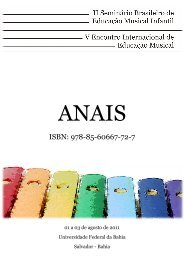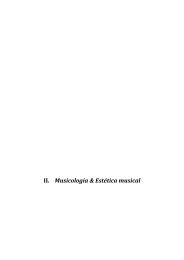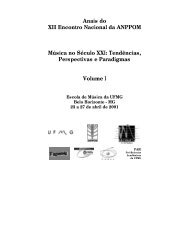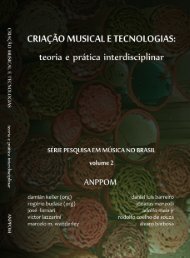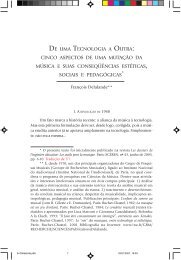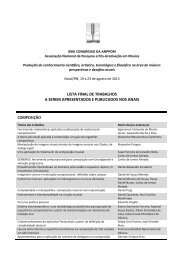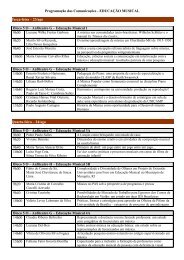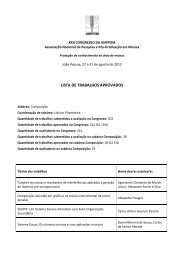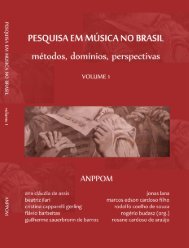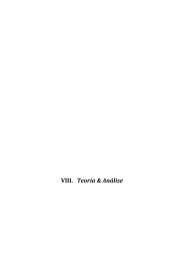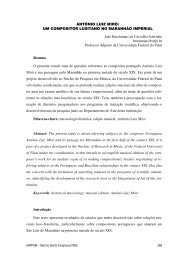download da versão impressa completa em pdf - anppom
download da versão impressa completa em pdf - anppom
download da versão impressa completa em pdf - anppom
You also want an ePaper? Increase the reach of your titles
YUMPU automatically turns print PDFs into web optimized ePapers that Google loves.
. . . . . . . . . . . . . . . . . . . . . . . . . . . . . . . . . . . . . . . . . . . . . . . . . . . . . . . . . . . . . . . . . DUWE; BARROS<br />
O trabalho de Rebecca Leydon sobre Debussy e o cin<strong>em</strong>a é muito melhor<br />
fun<strong>da</strong>mentado nas práticas de construção cin<strong>em</strong>atográfica do t<strong>em</strong>po do compositor<br />
e extrai interessantes conclusões relaciona<strong>da</strong>s ao cin<strong>em</strong>a francês e o nacionalismo.<br />
No entanto, ela também cita a passag<strong>em</strong> erroneamente traduzi<strong>da</strong> para estabelecer<br />
uma relação específica entre as “rupturas formais” <strong>da</strong>s técnicas do filme e as<br />
“soluções para o probl<strong>em</strong>a de continui<strong>da</strong>de e sucessão” <strong>em</strong> Debussy: “Dispositivos<br />
cin<strong>em</strong>atográficos, <strong>em</strong> outras palavras, pod<strong>em</strong> ter servido como uma fonte para novas<br />
opções formais que se tornaram disponíveis com o advento de um novo meio<br />
narrativo.” (Leydon, p. 223). De fato, eles pod<strong>em</strong> ter servido (mesmo que o lugar <strong>da</strong><br />
“ruptura” no cin<strong>em</strong>a seja mais uma vez supervalorizado aqui), e eu não posso provar<br />
que Debussy nunca pensou sobre cin<strong>em</strong>a nesses termos. Mas, a partir do momento<br />
<strong>em</strong> que as palavras do compositor são traduzi<strong>da</strong>s e entendi<strong>da</strong>s corretamente, as<br />
comparações afirma<strong>da</strong>s nesse estudo [...] v<strong>em</strong> a parecer mais como correlações s<strong>em</strong><br />
causa, heurísticas na melhor <strong>da</strong>s hipóteses. Leydon está sinceramente convicta, no<br />
entanto, <strong>da</strong> existência de uma genuína influência entre os meios, [...] e <strong>em</strong> parte por<br />
causa de suas abun<strong>da</strong>ntes “descontinui<strong>da</strong>des formais”, uma quali<strong>da</strong>de assumi<strong>da</strong><br />
novamente aqui como sendo de alguma forma essencial e original ao cin<strong>em</strong>a (Leydon,<br />
p. 232). Mesmo se Leydon localiza ex<strong>em</strong>plos persuasivos do que poderia ser ouvido<br />
como close-ups ou cortes cruzados sônicos nos trabalhos de Debussy, o privilégio<br />
<strong>da</strong>do à descontinui<strong>da</strong>de sintática como o sinal do cin<strong>em</strong>a cai presa de uma falácia<br />
familiar – encorajado e instigado por esse persistent<strong>em</strong>ente apelativo erro de<br />
tradução (PAULIN, 2010: 10, tradução nossa) 15.<br />
Tomando o que é levantado nesse trecho, procurar<strong>em</strong>os estabelecer nossa visão<br />
sobre a analogia entre a música e o cin<strong>em</strong>a. Em primeiro lugar, não acreditamos que o que<br />
motiva essa metodologia seja “encorajado e instigado” pelo erro de tradução (ao menos<br />
não é o que nos instiga). As propostas de interpretação que são levanta<strong>da</strong>s ao avaliar a<br />
15 “Rebecca Leydon's work on Debussy and cin<strong>em</strong>a is much better grounded in the filmmaking<br />
practices of the composer's time and draws interesting conclusions related to French film and<br />
nationalism. However, she also quotes the mistranslated passage to set up a specific correlation<br />
between the ‘formal disruptions’ of film technique and Debussy's ‘solutions for the probl<strong>em</strong> of<br />
continuity and succession’: ‘Cin<strong>em</strong>atic devices, in other words, may have served as a source of new<br />
formal options that became available with the advent of a new narrative medium.’ Indeed, they may<br />
have (even if the place of "disruption" in cin<strong>em</strong>a is once again overvalued here), and I cannot prove that<br />
Debussy never thought about cin<strong>em</strong>a in these terms. But once the composer's words are translated<br />
and understood correctly, the comparisons asserted in this study […] come to se<strong>em</strong> more like<br />
correlations without causation, euristic at best. Leydon is openly convinced, however, of a genuine<br />
intermedial influence, […] and partly because of its abun<strong>da</strong>nt 'formal discontinuity,' a quality assumed<br />
here yet again to be somehow essential and original to cin<strong>em</strong>a. Even if Leydon does locate persuasive<br />
examples of what might be heard as sonic close-ups or crosscuts in Debussy's works, her privileging of<br />
syntactic discontinuity as the sign of cin<strong>em</strong>a falls prey to a familiar fallacy—encouraged and abetted by<br />
this persistently appealing error of translation.” (PAULIN, 2010: 10).<br />
opus . . . . . . . . . . . . . . . . . . . . . . . . . . . . . . . . . . . . . . . . . . . . . . . . . . . . . . . . . . . . . . . . . . . . . . . . . . . . . 275



